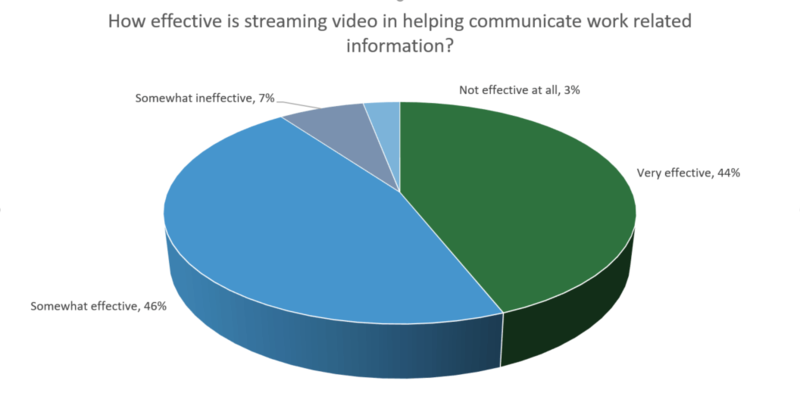e-Learning Ecologies MOOC’s Updates
Video learning
I am a product of traditional teaching and generally involved in conventional teaching. Attending this course through series of video lectures has been an interesting experience. Video learning is an important aspect of affordance 3 – multimodal learning. It an essential aspect of digital media where moving image and sound is created. Mary Kalantzis has beautifully explained in her video lecture that that digital ecology brings together speaking, listening, writing, and reading in a very meaningful and effective way (Figure 1). Video integrates the information in the form of text, image and sound to make it interesting and an engaging experience. It has become essential to support and augment one’s lecture, presentation with video, audio, or graphs/ tables [Cope and Kalantzis, 2017].
Figure 1. Effectiveness of video learning. Source: Analysis of Video Learning Effectiveness – Wainhouse Research (https://uploads.panopto.com/2019/05/30082251/panopto-video-learning-effectiveness-graphic.png)
According to Global Market Insights, E-learning market is projected to grow at over 8% CAGR (compounded annual growth rate) between 2020-2026 of value USD 375 billion in 2026 (Figure 2). [report ID: GMI215]. According to Cisco, the market for video learning is huge and 98% of the organizations will promote video-based learning [Report, 2020]. The choice of courses available on various educational sites like Coursera, EdX, Khan Academy, Swayam are mainly carried through video lectures.
Figure 2. Trends of E-learning market. [Report ID GMI215]
Important points or gains from digital media/ Video learning [Designing digitally, 2019; Kalantzis and Cope, 2015].
Flexible: I found learning through video lectures very flexible. I could choose time, place to listen, pause, take notes, and even look up the new concept. Learning platform can also be chosen according to convenience.
Access to subject experts: The choices available for subject matter experts to access the same topic is amazing.
Peer-to-peer collaborations: Earlier only movies as videos were available. The reach of the social platform like YouTube have changed the scenario and focused on collaborative work and studies. The closed book study or isolated student work has become antiquated after new media has become part of mainstream.
Focus on knowledge production process: The choice of material available to generate knowledge is vast and it is subject to change, feedback, and collaboration. They system has become more open to constructive opinion, as a result, the final product is continuously improved.
Reinforce the concept: Video where audio, moving image is involved for learning is a great way to explain the concept. In the last semester, while trying to explain the difficult topic, I found the open resource video useful. The students could grasp the concept or were assisted in ‘mastery learning’.
Thorough involvement: Video learning involves you completely which no other form of media does as the human brain can process video much faster than text. Learning through video is popular amongst learners especially the tech-savvy younger ones.
Promotes thinking: Videos involve multiple senses and stimulate cognitive connections.
Micro-learning: Videos grab attention as a result recall rate is better.
Cost effective: One can save on the cost of travel, infrastructure.
Limitations:
Passive training: Generally, the video learning is passive but now interactive training videos are also being designed.
Bandwidth issues
Difficult to find quality videos
Social interaction or peer group in a class does not get built up.
Overall, the video learning is effective and powerful, and I have found it crucial for reinforcing concepts. We as teachers, need to adapt and integrate it as part of our effective teaching.
References
Cope, B., and Kalantzis, M. (2017). Conceptualizing e-learning. In B. Cope and M. Kalantzis (Eds), e-Learning Ecologies. New York: Routledge.
Designing digitally. (2019). The benefits of video-based learning. https://www.designingdigitally.com/blog/2019/02/benefits-video-based-learning. Accessed on 25.07.20
Kalantzis, M., & Cope, B. (2015). Learning and new media. In D. Scott and E. Hargreaves (Eds.), The sage handbook of learning (pp. 373-387). Thousand Oaks CA: Sage.
Report ID GMI215. (2020). E-Learning Market Trends 2020-2026. Global Research Report.
Report (2020). Cisco Annual Internet Report (2018–2023) White Paper.




Thanks for sharing your thoughts on the use of video in learning. Why do you feel it is difficult to find quality videos? Are the difficulties with executing a search? Hopefully, YouTube and search engines will improve. Or are the difficulties due to a lack of appropriate videos on the publicly accessible Internet? If the latter is the case, how might video creation and sharing be enhanced?
As someone who has presented training for business groups, I strongly agree that well-chosen videos amplify the important course content and make it more memorable. Sometimes a humorous video is the key to opening-up students' minds to new concepts and tactics. I also agree that videos should engage thinking and be balanced with participative activities, thereby avoiding the classroom version of couch potato ;-)
The two statements you made that resonated with me most were that the brain processes video faster than text, and how effective video learning through the knowledge production process is. Thank you.